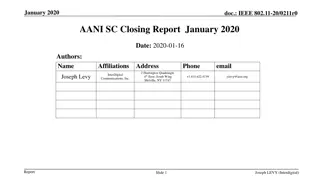
Understanding Saturated Hydrocarbons: Properties, Series, and Nomenclature
Explore the physical properties, homologous series, and nomenclature of saturated hydrocarbons. Learn how molecular size influences melting and boiling points, the concept of homologous series, and the IUPAC system for naming compounds. Discover the inert nature of alkanes and key chemical reactions involving saturated hydrocarbons.
Download Presentation

Please find below an Image/Link to download the presentation.
The content on the website is provided AS IS for your information and personal use only. It may not be sold, licensed, or shared on other websites without obtaining consent from the author. If you encounter any issues during the download, it is possible that the publisher has removed the file from their server.
You are allowed to download the files provided on this website for personal or commercial use, subject to the condition that they are used lawfully. All files are the property of their respective owners.
The content on the website is provided AS IS for your information and personal use only. It may not be sold, licensed, or shared on other websites without obtaining consent from the author.
E N D
Presentation Transcript
Physical Properties Table 2 lists the names and physical constants of the normal saturated hydrocarbons of 1 to 10 carbon atoms per molecule. The term normal applies to the isomer that has all its carbon atoms linked in a straight chain. The others are referred to as branched-chain compounds. The branched form of butane and the simplest branched form of pentane are commonly given the prefix iso-. The saturated hydrocarbons are colorless, practically odorless, and quite insoluble in water, particularly those with five or more carbon atoms. They dissolve readily in many organic solvents. At room temperature all members through C5 are gases, those from C6 to C17 are liquids, and those above C17 are solids. Data in Table 2 show that as molecular size increases, the melting and boiling points of alkanes increase. Solubility in water in general decreases with increasing size. Such relationships are important in understanding the behavior of organic compounds in the environment and in engineered reactors.
Homologous Series It will be noted from Table 2 that each successive member of the series differs from the previous member by CH2. When the formulas of a series of compounds differ by a common increment, such as CH2, the series is referred to as being a homologous series. Such compounds can be expressed by a general formula. That for the alkane series is CnH2n+2. Radicals The inert character of the alkanes has been mentioned; however, they may be made to react under the proper conditions and a wide variety of compounds results. It becomes necessary, therefore, to establish some form of nomenclature to identify the products formed. When one hydrogen is replaced from a molecule of an alkane, the -ane ending is dropped and a -yl is added. The names of some radicals are shown in Table 3. The system serves quite well for the normal compounds but is of little value in naming derivatives of the isomers.
NOMENCLATURE THE ALKANES ARE CHARACTERIZED BY NAMES ENDING IN -ANE. THE STRAIGHT-CHAIN COMPOUNDS ARE TERMED NORMAL COMPOUNDS. THE BRANCHED-CHAIN COMPOUNDS AND THE DERIVATIVES OF BOTH STRAIGHT- AND BRANCHED-CHAIN COMPOUNDS ARE DIFFICULT TO NAME WITH ANY DEGREE OF SPECIFICITY. THE IUPAC SYSTEM, AS PROPOSED BY THE INTERNATIONAL UNION OF PURE AND APPLIED CHEMISTRY, IS COMMONLY USED. IN THIS SYSTEM THE COMPOUNDS ARE NAMED IN TERMS OF THE LONGEST CONTINUOUS CHAIN OF CARBON ATOMS IN THE MOLECULE. A FEW EXAMPLES WILL ILLUSTRATE THE METHOD.
It will be noted that a chain is numbered from the end nearest the attached radical. The rule is to make the numbers as small as possible. The IUPAC system is applied to other compounds as well as to hydrocarbons.
CHEMICAL REACTIONS STRONG BASES, ACIDS, OR AQUEOUS SOLUTIONS OF OXIDIZING AGENTS DO NOT REACT WITH SATURATED HYDROCARBONS AT ROOM TEMPERATURE. AT ELEVATED TEMPERATURES, STRONG OXIDIZING AGENTS, SUCH AS CONCENTRATED SULFURIC ACID, OXIDIZE THE COMPOUNDS TO CARBON DIOXIDE AND WATER. OTHER REACTIONS OF IMPORTANCE ARE AS FOLLOWS: 1. OXIDATION WITH OXYGEN OR AIR: 2. SUBSTITUTION OF HYDROGEN BY HALOGENS: THIS REACTION DOES NOT ORDINARILY OCCUR IN AQUEOUS SOLUTIONS AND THEREFORE IS OF LITTLE SIGNIFICANCE IN ENVIRONMENTAL ENGINEERING AND SCIENCE.
3. PYROLYSIS OR CRACKING: HIGH-MOLECULAR-WEIGHT HYDROCARBONS MAY BE BROKEN INTO SMALLER MOLECULES BY HEAT TREATMENT. THE PROCESS IS USED IN THE PETROLEUM INDUSTRY TO INCREASE THE YIELD OF LIGHT BOILING FRACTIONS, SUITABLE FOR SALE AS GASOLINE OR FOR CHEMICAL SYNTHESIS. HEAT TREATMENT RESULTS IN DISRUPTION OF THE LARGE MOLECULES AS FOLLOWS:
4. BIOLOGICAL OXIDATION: HYDROCARBONS ARE OXIDIZED BY CERTAIN BACTERIA UNDER AEROBIC CONDITIONS. THE OXIDATION PROCEEDS THROUGH SEVERAL STEPS. THE FIRST STEP IS VERY SLOW BIOLOGICALLY AND INVOLVES CONVERSION TO ALCOHOLS WITH ATTACK OCCURRING ON TERMINAL CARBON ATOMS, I.E., OMEGA OXIDATION. THROUGH ADDITIONAL OXIDATIVE STEPS, MICROORGANISMS CONVERT THE HYDROCARBON TO CARBON DIOXIDE AND WATER AND DERIVE ENERGY IN THE PROCESS. SUCH REACTIONS, PARTICULARLY THE INTERMEDIATE STEPS, ARE OF GREAT INTEREST TO ENVIRONMENTAL ENGINEERING AND SCIENCE.
UNSATURATED HYDROCARBONS THE UNSATURATED HYDROCARBONS ARE USUALLY SEPARATED INTO FOUR CLASSES. ALKENES EACH MEMBER OF THE ALKANE GROUP EXCEPT METHANE CAN LOSE HYDROGEN TO FORM AN UNSATURATED COMPOUND OR ALKENE. THE ALKENES ALL CONTAIN ONE DOUBLE BOND BETWEEN TWO ADJACENT CARBON ATOMS, AND THEIR NAMES ALL END IN -YLENE (OLDER NOMENCLATURE) OR -ENE. THE ALKENES ARE ALSO CALLED OLEFINS. ALKENES, PARTICULARLY ETHENE, PROPENE, AND BUTENE ARE FORMED IN GREAT QUANTITIES DURING THE CRACKING OR PYROLYSIS OF PETROLEUM. THE NAMES, FORMULAS, AND PHYSICAL CONSTANTS OF A NUMBER OF IMPORTANT ALKENES ARE GIVEN IN TABLE 4. IN NAMING SPECIFIC ALKENES, THE IUPAC SYSTEM MUST BE EMPLOYED ON ALL COMPOUNDS WITH OVER THREE CARBON ATOMS. THE NOMENCLATURE BECOMES QUITE COMPLICATED WITH BRANCHED-CHAIN ISOMERS. FORTUNATELY, THERE IS LITTLE REASON TO DIFFERENTIATE BETWEEN NORMAL AND BRANCHED-CHAIN COMPOUNDS IN THIS SERIES.
DIOLEFINS WHEN ALIPHATIC COMPOUNDS CONTAIN TWO DOUBLE BONDS IN THE MOLECULE, THEY ARE CALLED ALKADIENES, SOMETIMES DIENES FOR SHORT. THE COMPOUND 1,3-BUTADIENE IS AN IMPORTANT EXAMPLE: IT HAS BEEN USED TO MAKE POLYMERS. ALKADIENES SOME ORGANIC COMPOUNDS CONTAIN MORE THAN TWO DOUBLE BONDS PER MOLECULE. THE RED COLORING MATTER OF TOMATOES, LYCOPENE, AND THE YELLOW COLORING MATTER OF CARROTS ARE EXAMPLES. THESE COMPOUNDS ARE OF INTEREST BECAUSE OF THEIR OCCURRENCE IN INDUSTRIAL WASTES PRODUCED IN THE PREPARATION OF VEGETABLES FOR CANNING. THE OXIDANT (E.G., CHLORINE) DEMAND OF SUCH WASTES IS EXTREMELY HIGH.
ALKYNES THE ALKYNES HAVE A TRIPLE BOND BETWEEN ADJACENT CARBON ATOMS. THESE COMPOUNDS ARE FOUND TO SOME EXTENT IN INDUSTRIAL WASTES FROM CERTAIN INDUSTRIES, PARTICULARLY THOSE FROM THE MANUFACTURE OF SOME TYPES OF SYNTHETIC RUBBER. CHEMICAL REACTIONS UNSATURATED LINKAGES OCCUR IN MANY TYPES OF ORGANIC COMPOUNDS AND EXHIBIT MANY PROPERTIES IN COMMON, REGARDLESS OF THE TYPE OF COMPOUND IN WHICH THEY EXIST. UNSATURATED COMPOUNDS UNDERGO SEVERAL REACTIONS WITH RELATIVE EASE. 1. OXIDATION: THE COMPOUNDS ARE EASILY OXIDIZED IN AQUEOUS SOLUTION BY OXIDIZING AGENTS SUCH AS POTASSIUM PERMANGANATE. A GLYCOL IS THE NORMAL PRODUCT. 2. REDUCTION: UNDER SPECIAL CONDITIONS OF TEMPERATURE, PRESSURE, AND CATALYSIS, HYDROGEN MAY BE CAUSED TO ADD AT DOUBLE OR TRIPLE BONDS. THIS REACTION IS OF CONSIDERABLE IMPORTANCE COMMERCIALLY IN THE CONVERSION OF VEGETABLE OILS TO SOLID FATS. MUCH VEGETABLE SHORTENING ARE MADE BY THIS PROCESS.
3. ADDITION: HALOGEN ACIDS, HYPOCHLOROUS ACID, AND HALOGENS WILL ADD ACROSS UNSATURATED LINKAGES. The reaction with hypochlorous acid is most important. Industrial wastes containing appreciable amounts of unsaturated compounds exhibit high chlorine-demand values because of such reactions. 4. Polymerization: Molecules of certain compounds having unsaturated linkages are prone to combine with each other to form polymers of higher molecular weight. Similar reactions serve as the basis for many industrial products, e.g., synthetic resins, synthetic fibers, synthetic rubber, and synthetic detergents. Industrial wastes from such industries can be expected to contain a wide variety of polymers and usually exhibit a high chlorine demand. Historically such wastes were treated by chlorination. This practice is currently discouraged because the chlorinated organic compounds so formed have adverse impacts to human health and the environment.
5. BACTERIAL OXIDATION: IT IS GENERALLY CONSIDERED THAT ORGANIC COMPOUNDS POSSESSING UNSATURATED LINKAGES ARE MORE PRONE TO BACTERIAL OXIDATION THAN CORRESPONDING SATURATED COMPOUNDS BECAUSE OF THE EASE OF OXIDATION AT THE DOUBLE BONDS.



















